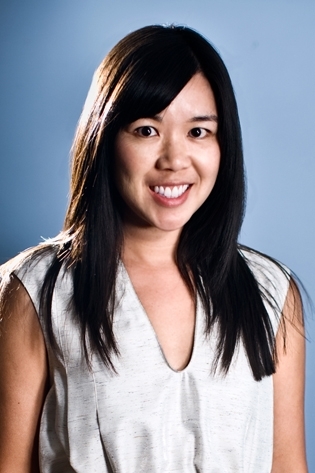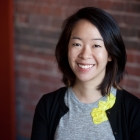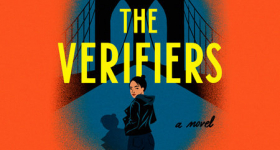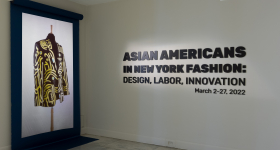A discussion of the digital fashion media complex, fashion shows in Japanese American internment camps and the aesthetic value of UGG boots with Minh-Ha T. Pham, founder of the blog Of Another Fashion, an online archive highlighting the oft-ignored fashion histories of American women of color.
A photo of Minh-Ha T. Pham's mom in Vietnam in 1966 wearing an outfit from Sears, from the blog Of Another Fashion. Courtesy Minh-Ha T. Pham.
In Issue 24: The Survival Issue, we highlight the blog Of Another Fashion, an online archive highlighting the oft-ignored fashion histories of American women of color.
The site’s founder, Minh-Ha T. Pham, is an assistant professor in the art history and Asian American studies programs at Cornell University. Born in Vietnam, Pham grew up in southern California wearing clothes made by her sartorially minded mother, which proved formative to her interest in fashion design.
While earning her doctorate in ethnic studies at UC Berkeley, she found a fashion kindred spirit in fellow Berkeley grad student Mimi Thi Nguyen, and in 2007 the pair launched the blog Threadbared, which thoughtfully considers the politics, aesthetics, histories, theories, and cultures of fashion and beauty.
In person, the 37-year-old academic is easy chic, in a slouchy grey sweater with a braided trim, rolled-up navy chinos, brown oxfords and an ominous black-mirrored steel claw ring. Pham discussed her project assessing the digital fashion media complex, the enthusiastic reception of Of Another Fashion, and how she failed to inherit the sewing gene from her mother.
Tell me about the genesis of Threadbared.
We found ourselves really dissatisfied with how academics talk about fashion. We wanted to ask larger questions, like how is fashion part of the cultural and political economy? What is the relationship of fashion to power? That’s what Threadbared is about -- it’s a cultural studies blog about fashion and the politics and economies of fashion.
How did Threadbared lead to your academic work on the digital fashion media complex?
Since doing Threadbared, I’ve really become interested in issues of new media, particularly questions about the economy and labor. So many people have a blog, or Tumblr, or tweet. Look at how much time people devote to these activities, which are mostly for free. I spend so much time blogging, and if I could get paid for this, it would be amazing! But it doesn’t count for tenure.
My book project looks at fashion blogs, virtual fitting rooms, and fashion-themed apps, but also in the broader view race, gender, and labor in the new media economy. The working title is Technochic: Fashion, Media and the New Innovation Economy. Fashion bloggers especially are so crucial now to the fashion economy, especially star bloggers. Generating that kind of buzz now happens online more than in marketing departments or ad rooms.

Minh-Ha T. Pham
Have you always been interested in fashion?
I always loved to shop. My mom is an amazing dressmaker. When we were growing up, she made almost all of our clothes, made all of her clothes, and studied clothes. We’d go shopping, but we were poor so we didn’t buy anything. But she’d spend hours studying clothes. Then she’d go home and make it. I had this appreciation for construction long before I consciously knew I was paying attention to my mom doing that stuff. I didn’t inherit that gene, which is really too bad because I would love to learn to sew. I’ve taken classes; I just can’t do it. I’m very slow. I don’t have a talent for it clearly.
In college, fashion still isn’t considered a legitimate research site, so I never considered I could do something on this until Threadbared. Then I started asking very analytical questions. The fashion studies out there left me unsatisfied. There needs to be another voice that’s talking about the fashion industry in broader ways. Fashion’s not just about the clothes and materials, but also about the economy, politics, and culture.
Talk about the inspiration for Of Another Fashion.
It started with a Threadbared post where I talked about an article in The Washington Post about the Smithsonian receiving the entire Black Fashion Museum’s collection. I had never heard of the Black Fashion Museum, and while looking into it I also learned about Harlem Institute of Fashion. These are huge institutions, and it got me wondering, why don’t we know about these things? What other fashion histories do we not know about? We all know when couture was invented. We know about European fashion, and how it became American fashion. But what about the fashion histories of Asian American women who have been here for so long? Latinas? Native women who have been here even before there was a United State?
When I was in New York I went to a lot of fashion exhibitions, many of which were about fashion and nationalism: American Fashion, the American Woman, things like that. None of them really focused on the kinds of fashion that I was interested in. They would focus on couture fashion or designer fashion. Women of color historically didn’t have access to those luxury fashions. It inherently excluded them, or it focused on eveningwear but not the everyday clothes. These national fashion exhibitions didn’t include women of color implicity, though not overtly.
I was thinking out loud on the blog, “Wouldn’t it be great to have an exhibition that focused on these other fashions?” A couple of people emailed saying I should do that. Six months later I finally sat down to do something about it.
What has the reaction been?
I’m getting so much enthusiasm. People email me saying, “I have this photograph of my mom and she looks so great!” I also got a lot emails saying, “I wish I still had that.” That was really frustrating. Part of the exhibition is going to be about that kind of loss. A lot of these objects weren’t saved, or if they were saved, they weren’t stored properly, which is why the exhibition is more visual-based than garment-based. Most fashion exhibitions have mostly garments. I think this is going to be more photographs and maybe even audio/video narrative, where we would interview women talking about this dress or their mom’s style. That’s how these fashion histories now are being passed along because there’s not an archive for them.
What is your ultimate goal with Of Another Fashion?
The first goal is my own intellectual curiosity: what are these other histories we don’t know about? What does it mean when we imagine a Latina women in the ‘50s wearing a poodle skirt? That’s an image we never see but it must have existed.
The second is, what would it mean thinking about, for example, my mom in the 60s in cigarette pants, dressed just like Mary Tyler Moore? How does that change what we imagine the fashionable body is? In general when we think about the fashionable body, it’s an implicitly white, thin body. This has implications not just for rethinking fashion history but rethinking American history and the role of American women, American popular culture and history.
The other one is to get community involvement. It’s really important that people actually submit photographs and articles of clothing because there is no museum I can go to, no archive, nothing. This is going to require people digging through their closets, attics, basements, and trusting me enough to send me the stuff. Clothes and photographs are not considered important enough to save, so they don’t know where they put that coat that they made, and it’s gone. Either it wasn’t saved or it’s so precious that no one’s willing to let it out of their hands. These are challenges for this project.
For a lot of women of color, they didn’t buy Chanel or Gucci. They bought secondhand or they home made their clothes or they altered budget label clothes bought at Woolworth’s. Fashion is about the original design. Well that doesn’t really exist here. They either weren’t the first owners, or they’ve altered it, or given it away. These histories are very ephemeral. I’d like the blog to not shy away from these challenges but deal with them. If the histories are lost and ephemeral and fragile, I want it to be reflected. It underscores the consequences of making these histories insignificant, the consequences of curatorial and critical neglect of these histories.
Is it an issue of women of color not preserving their clothes as well as white women?
We live in a consumer, disposable society. We all get rid of our clothes really fast when we don’t want to wear them. If you grew up in a family when your mom’s closet was full of furs and Chanel, you know that these might be worth something or important somehow, even if just important to you. The fashion design hierarchy is such that couture and luxury labels are on top, and secondhand, Woolworth’s and JC Penney labels are at the bottom. It’s a combination of race and class. I do think that a lot of women of color have internalized the idea that their clothes and their fashion history don’t matter. No, you don’t keep it, you don’t honor and respect it. You don’t consider it important. Am I really gonna pay to have it preserved if I bought it at Woolworth’s, JC Penney? The museums tell me it’s worth nothing, there aren’t fashion histories written about it.
Tell me about some of your favorite submissions so far.
All the photographs of [Japanese American] internment and the fashion shows there. The fact that one of the activities in interment camps were fashion shows just kills me, I mean, it’s just so fabulous, right? Also women’s culture is never really thought about when you think about war. This is about fashion in wartime. We know about Rosie the Riveter, but this is pretty fabulous. They made these clothes. People were making clothes [in internment camps]. That blows me away.
The image of my mom [at top] -- I absolutely love it. She looks like a Hollywood starlet there. The cateye glasses, the red cigarette pants on. This is in Vietnam but the clothes were purchased in the United States. Her sister, my aunt, was an exchange student in college and bought all of these clothes at Sears and brought them home.
Will you feature celebrities on the blog?
I’m not really interested in famous people. We know Anna May Wong. We know Dorothy Dandridge. Those women were actually very privileged. I mean, they absolutely experienced racism, but they were also very privileged. I’m looking at the way everyday women negotiated limitations and found creative ways to express their selves. I want community involvement, I want the women we don’t get to see. For so many of these photographs, what I really love about them are the stories. It’s cool to allow people some time to talk about their grandmothers, aunts, and fashionable relatives.
What about women in ethnic clothing?
There’s not going to be any. The subtitle of the project is “Claiming America Through Dress.” I’m interested in how women of color contributed to and were informed by American popular culture. There’s a fine line. It’s a little dangerous, right? On one hand, the exhibition can feel a little assimilative. On the other hand it’s really ridiculous to think that women of color weren’t influenced by American culture, which was all around them. Not only were they were influenced by American culture but they contributed to it. That’s what this project is. It’s a very narrow scope.
Of course we’ve seen historical photographs of women of color in ethnically marked clothing, and that’s fine, that’s great. But when we only see women of color in ethnically marked clothing, what it suggests is that they’re actually not American: they’re from where their clothes are from. Even if they’ve lived here for 20 years, it suggests they haven’t modernized. I’m not saying there’s anything wrong with saris or cheongsams. When you only see women dressed like that it kind of fixes the image in this moment in time.
Do “unfashionable” women have a place on your blog?
I don’t make those judgments. Of course I do in my head, but mostly I think, “That’s really boring.” I respect people who are sartorial risk-takers. If you put an outfit together that’s kind of crazy, I’m probably gonna respect the hell out of you even if I wouldn’t wear it. There are a lot of things I wouldn’t wear but that I absolutely love anyway. I don’t believe in fashion rules. I believe in Wear what makes you feel good about yourself, Wear what makes you feel happy. Fashion should be fun, it shouldn’t take itself too seriously even though I think fashion is serious in the way it impacts and is informed by politics and the economy. I think racism is unfashionable. I think homophobia is unfashionable.
All the photos look so fashionable but I wonder if part of it is the gloss of nostalgia. In 30 years, would you put someone in a Juicy Couture tracksuit on the blog?
There are things I hate. I hate UGG boots, Crocs, Juicy velour tracksuits. They are just aesthetically unpleasing. I have such an aversion to having grown up in L.A., and I associate Juicy velour tracksuits plus Louis Vuitton handbags plus a big SUV to be so LA to me. But that’s different from saying, “I look down on your because you wear this." I just tend to think we have very different styles and we shouldn’t go shopping together. So, yes, I would put them on the blog because that was the moment. You would associate velour tracksuits with the “Juicy” on the butt with 1990s or early 2000s.
It’s funny, the most popular image, the one that’s gotten the most reblogging and likes was the one of the three women who were Chicana gangsters who were arrested [wearing loose-fitting pants]. But most of these women are wearing dresses, most are recognizable feminine, recognizable fashionable. There is a normativity about it that I do recognize. But the scope of this is really narrow. I’m interested in intervening on how we understand fashion and fashionable bodies. Also these women on the blog were intending to be fashionable. Women who wear tracksuits, they wear that to go to Starbucks. They don’t wear that to dinner. It’s their leisure wear.
What do these photos and artifacts reveal about women and fashion?
What they reveal about fashion is that it’s a very powerful cultural influence. It crosses racial-class boundaries. But that doesn’t mean it allows these people to have access to fashion. Depending on your class and race, your level of access is very different. Fashion is a really powerful institution, for better and for worse. It also circulates and broadcasts very terrible images about bodies and femininity and beauty.
It reveals women are amazingly creative, and not just in that they can make dresses, sew and alter their clothes. My mom, in 1966, when that picture was taken, Vietnam was in a war. Women find time for pleasure, time to look good, and that’s amazing. Pleasure isn’t just the province of rich people. Glamour and beauty aren’t the exclusive properties of rich white women, even though if you look through Vogue that’s what you might think. These were women who had limits and managed to negotiate limitations. Think about how exhausting having to work 50 or 60 hours a week if you’re poor, working-class and still manage to go out at night and get dressed up. That’s amazing.
It’s that spirit I want to convey through Of Another Fashion: the spirit of creativity, the energy and fun. When you talk about women of color and fashion, we usually talk about sweatshops or racism in fashion magazines. But what we don’t talk about is women of color having fun with fashion. Fashion is a cultural force and it’d be silly to think that it somehow missed women of color.










Comments